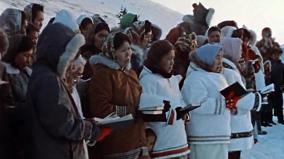Amarok's Song - The Journey to Nunavut
In this feature-length documentary, three generations of the Caribou Inuit family come together to tell the story of their journey as Canada's last nomads. From the independent life of hunting on the Keewatin tundra to taking the reins of the new territory of Nunavut on April 1, 1999, we see it all. The film is the result of a close collaboration between Ole Gjerstad, a southern Canadian, and Martin Kreelak, an Inuk. It's Martin's family that we follow, as the story is told through his own voice, through those of the Elders, and through those of the teens and young …

Details
The film is the result of a close collaboration between Ole Gjerstad, a southern Canadian, and Martin Kreelak, an Inuk. It's Martin's family that we follow, as the story is told through his own voice, through those of the Elders, and through those of the teens and young adults who were born in the settlements and form the first generation of those growing up with satellite TV and a permanent home.
-
directorMartin KreelakOle Gjerstad
-
producerLucie PageauMalcolm GuyJanice EppOle GjerstadJoe MacDonald
-
executive producerGraydon McCrea
-
scriptOle GjerstadMartin Kreelak
-
cameraAndrei KhabadMichael Parsons
-
soundSamuel IqtiliqNick Huard
-
editingHoward Goldberg
-
sound editingPaul Herspiegel
-
mixPaul Herspiegel
-
musicJanet LumbDino Giancola

















